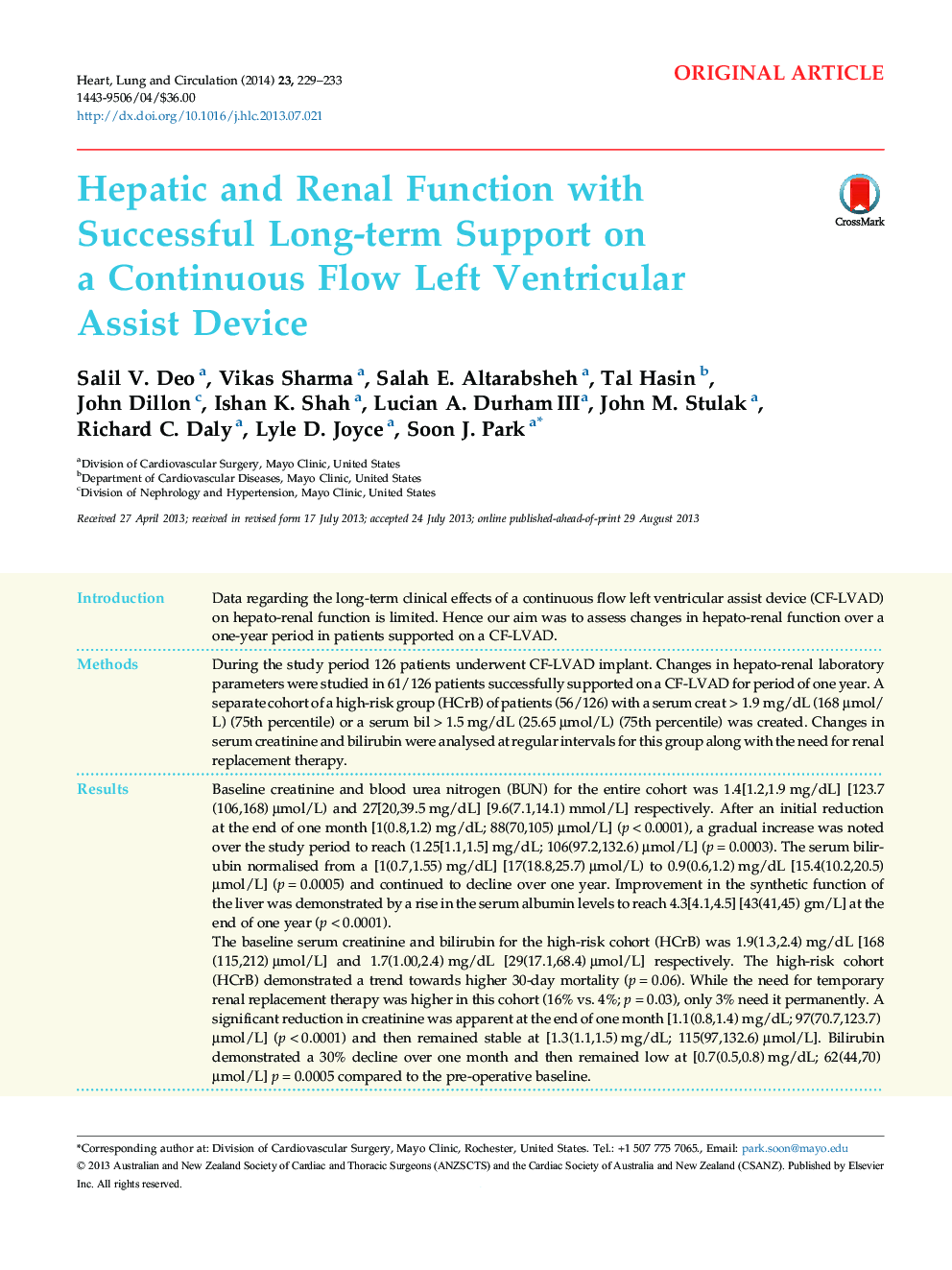| کد مقاله | کد نشریه | سال انتشار | مقاله انگلیسی | نسخه تمام متن |
|---|---|---|---|---|
| 2917862 | 1175675 | 2014 | 5 صفحه PDF | دانلود رایگان |
IntroductionData regarding the long-term clinical effects of a continuous flow left ventricular assist device (CF-LVAD) on hepato-renal function is limited. Hence our aim was to assess changes in hepato-renal function over a one-year period in patients supported on a CF-LVAD.MethodsDuring the study period 126 patients underwent CF-LVAD implant. Changes in hepato-renal laboratory parameters were studied in 61/126 patients successfully supported on a CF-LVAD for period of one year. A separate cohort of a high-risk group (HCrB) of patients (56/126) with a serum creat > 1.9 mg/dL (168 μmol/L) (75th percentile) or a serum bil > 1.5 mg/dL (25.65 μmol/L) (75th percentile) was created. Changes in serum creatinine and bilirubin were analysed at regular intervals for this group along with the need for renal replacement therapy.ResultsBaseline creatinine and blood urea nitrogen (BUN) for the entire cohort was 1.4[1.2,1.9 mg/dL] [123.7(106,168) μmol/L) and 27[20,39.5 mg/dL] [9.6(7.1,14.1) mmol/L] respectively. After an initial reduction at the end of one month [1(0.8,1.2) mg/dL; 88(70,105) μmol/L] (p < 0.0001), a gradual increase was noted over the study period to reach (1.25[1.1,1.5] mg/dL; 106(97.2,132.6) μmol/L] (p = 0.0003). The serum bilirubin normalised from a [1(0.7,1.55) mg/dL] [17(18.8,25.7) μmol/L) to 0.9(0.6,1.2) mg/dL [15.4(10.2,20.5) μmol/L] (p = 0.0005) and continued to decline over one year. Improvement in the synthetic function of the liver was demonstrated by a rise in the serum albumin levels to reach 4.3[4.1,4.5] [43(41,45) gm/L] at the end of one year (p < 0.0001).The baseline serum creatinine and bilirubin for the high-risk cohort (HCrB) was 1.9(1.3,2.4) mg/dL [168(115,212) μmol/L] and 1.7(1.00,2.4) mg/dL [29(17.1,68.4) μmol/L] respectively. The high-risk cohort (HCrB) demonstrated a trend towards higher 30-day mortality (p = 0.06). While the need for temporary renal replacement therapy was higher in this cohort (16% vs. 4%; p = 0.03), only 3% need it permanently. A significant reduction in creatinine was apparent at the end of one month [1.1(0.8,1.4) mg/dL; 97(70.7,123.7) μmol/L] (p < 0.0001) and then remained stable at [1.3(1.1,1.5) mg/dL; 115(97,132.6) μmol/L]. Bilirubin demonstrated a 30% decline over one month and then remained low at [0.7(0.5,0.8) mg/dL; 62(44,70) μmol/L] p = 0.0005 compared to the pre-operative baseline.ConclusionHepato-renal function demonstrates early improvement and then remains stable in the majority of patients on continuous flow left ventricular assist device support for one year. High-risk patients demonstrate a higher 30-day mortality and temporary need for renal replacement therapy. Yet even in this cohort, improvement is present over a period of one year on the device, with a minimal need for permanent haemodialysis.
Journal: Heart, Lung and Circulation - Volume 23, Issue 3, March 2014, Pages 229–233
